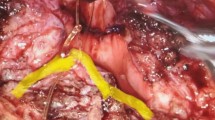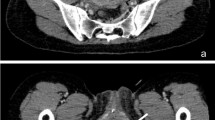Abstract
Multiple causes at any level between the brain and the bladder can lead to diminished voiding efficiency and bladder acontractility. Treatment options for patients with an acontractile bladder have been limited as most patients were forced to perform lifelong self-catheterization at the moment. The latissimus dorsi detrusor myoplasty (LDDM) is a recent and promising therapeutic surgical option to restore adequate bladder emptying on demand. This article critically reviews the available literature on LDDM and focuses particularly on the preoperative diagnostic evaluation and patient selection, treatment outcome and the postoperative contractility measurement.


Similar content being viewed by others
References
Papers of particular interest, published recently, have been highlighted as: • Of importance •• Of major importance
de Seze M, Ruffion A, Denys P, Joseph PA, Perrouin-Verbe B, Genulf. The neurogenic bladder in multiple sclerosis: review of the literature and proposal of management guidelines. Mult Scler. 2007;13(7):915–28. PubMed PMID: 17881401.
Sakakibara R, Uchiyama T, Yamanishi T, Shirai K, Hattori T. Bladder and bowel dysfunction in Parkinson's disease. J Neural Transm. 2008;115(3):443–60. PubMed PMID: 18327532.
Sakakibara R, Hattori T, Uchiyama T, Yamanishi T. Videourodynamic and sphincter motor unit potential analyses in Parkinson's disease and multiple system atrophy. J Neurol Neurosurg Psychiatry. 2001;71(5):600–6. PubMed PMID: 11606669. Pubmed Central PMCID: 1737611.
Bloch F, Pichon B, Bonnet AM, et al. Urodynamic analysis in multiple system atrophy: characterisation of detrusor-sphincter dyssynergia. J Neurol. 2010;257(12):1986–91. PubMed PMID: 20683607.
Tibaek S, Gard G, Klarskov P, Iversen HK, Dehlendorff C, Jensen R. Prevalence of lower urinary tract symptoms (LUTS) in stroke patients: a cross-sectional, clinical survey. Neurourol Urodyn. 2008;27(8):763–71. PubMed PMID: 18551565.
Diokno AC, Brock BM, Brown MB, Herzog AR. Prevalence of urinary incontinence and other urological symptoms in the noninstitutionalized elderly. J Urol. 1986;136(5):1022–5. PubMed PMID: 3490584.
van Kerrebroeck PE, van Voskuilen AC, Heesakkers JP, et al. Results of sacral neuromodulation therapy for urinary voiding dysfunction: outcomes of a prospective, worldwide clinical study. J Urol. 2007;178(5):2029–34. PubMed PMID: 17869298.
White WM, Dobmeyer-Dittrich C, Klein FA, Wallace LS. Sacral nerve stimulation for treatment of refractory urinary retention: long-term efficacy and durability. Urology. 2008;71(1):71–4. PubMed PMID: 18242368.
• Ginsberg DA. Bladder acontractility: detrusor myoplasty and other options. Nat Rev Urol. 2011;8(4):185–6. PubMed PMID: 21475331. A critical review regarding the treatment options for bladder acontractility, specifically highlighting that adverse outcomes occur in patients performing CISC, however not too regularly. Secondly, CISC gives improvement in the quality of life instead of psychological burden as noted in other studies.
Stenzl A, Ninkovic M, Willeit J, et al. Free neurovascular transfer of latissimus dorsi muscle to the bladder. I. Experimental studies. J Urol. 1997;157(3):1103–8. PubMed PMID: 9072552.
Katona F, Berenyi M. Intravesical transurethral electrotherapy of bladder paralysis. Orvosi hetilap. 1975;116(15):854–6. PubMed PMID: 1079080. Hugyholyagbenulasok intravesicalis, transurethralis electrotherapiaja.
Katona F. Stages of vegatative afferentation in reorganization of bladder control during intravesical electrotherapy. Urol Int. 1975;30(3):192–203. PubMed PMID: 1078920.
Katona F, Berenyi M. Intravesical transurethral electrotherapy in meningomyelocele patients. Acta Paediatr Acad Sci Hung. 1975;16(3–4):363–74. PubMed PMID: 773096.
Cheng EY, Richards I, Balcom A, et al. Bladder stimulation therapy improves bladder compliance: results from a multi-institutional trial. J Urol. 1996;156(2 Pt 2):761–4. PubMed PMID: 8683778.
Brindley GS. History of the sacral anterior root stimulator, 1969–1982. Neurourol Urodyn. 1993;12(5):481–3. PubMed PMID: 8252052.
Brindley GS, Polkey CE, Rushton DN, Cardozo L. Sacral anterior root stimulators for bladder control in paraplegia: the first 50 cases. J Neurol Neurosurg Psychiatry. 1986;49(10):1104–14. PubMed PMID: 3491180. Pubmed Central PMCID: 1029041.
Leng WW, Chancellor MB. How sacral nerve stimulation neuromodulation works. Urol Clin North Am. 2005;32(1):11–8. PubMed PMID: 15698871.
Messing EM, Dibbell DG, Belzer FO. Bilateral rectus femoris pedicle flaps for detrusor augmentation in the prune belly syndrome. J Urol. 1985;134(6):1202–5. PubMed PMID: 2932560.
Zhang YH, Shao QA, Wang JM. Enveloping the bladder with displacement of flap of the rectus abdominis muscle for the treatment of neurogenic bladder. J Urol. 1990;144(5):1194–5. PubMed PMID: 2146404.
Chancellor MB, Rivas DA, Salzman SK. Detrusor-myoplasty to restore micturition. Lancet. 1994;343(8898):669. PubMed PMID: 7906824.
Van Savage JG, Perez-Abadia G, Palanca LG, et al. Comparison of the experience with acute and chronic electrically stimulated detrusor myoplasty. Neurourol Urodyn. 2002;21(5):516–21. PubMed PMID: 12232891.
Ninkovic M, Dabernig W. Flap technology for reconstructions of urogenital organs. Curr Opin Urol. 2003;13(6):483–8. PubMed PMID: 14560143.
Maxwell GP. Iginio Tansini and the origin of the latissimus dorsi musculocutaneous flap. Plast Reconstr Surg. 1980;65(5):686–92. PubMed PMID: 6988856.
Olivari N. The latissimus flap. Br J Plast Surg. 1976;29(2):126–8. PubMed PMID: 776304.
McCraw JB, Dibbell DG. Experimental definition of independent myocutaneous vascular territories. Plast Reconstr Surg. 1977;60(2):212–20. PubMed PMID: 329302.
McCraw JB, Dibbell DG, Carraway JH. Clinical definition of independent myocutaneous vascular territories. Plast Reconstr Surg. 1977;60(3):341–52. PubMed PMID: 142995.
von Heyden B, Anthony JP, Kaula N, Brock GB, Jakse G, Tanagho EA. The latissimus dorsi muscle for detrusor assistance: functional recovery after nerve division and repair. J Urol. 1994;151(4):1081–7. PubMed PMID: 8126798.
Stenzl A, Ninkovic M, Kolle D, Knapp R, Anderl H, Bartsch G. Restoration of voluntary emptying of the bladder by transplantation of innervated free skeletal muscle. Lancet. 1998;351(9114):1483–5. PubMed PMID: 9605805.
Stenzl A. Free neurovascular transfer of latissimus dorsi muscle for the treatment of bladder acontractility: II. Clinical results. Int Braz J Urol Off J Braz Soc Urol. 2003;29(2):179–80. PubMed PMID: 15745513.
Stenzl A, Strasser H, Klima G, et al. Reconstruction of the lower urinary tract using autologous muscle transfer and cell seeding: current status and future perspectives. World J Urol. 2000;18(1):44–50. PubMed PMID: 10766043.
•• Gakis G, Ninkovic M, van Koeveringe GA, et al. Functional detrusor myoplasty for bladder acontractility: long-term results. J Urol. 2011;185(2):593–9. PubMed PMID: 21168866. This multicenter study showed the long-term results of LDDM in the largest patient population published, with a complete response rate of 70.8 %. Furthermore, the study confirmed the earlier noted relatively low complication rates.
Spear SL, Hess CL. A review of the biomechanical and functional changes in the shoulder following transfer of the latissimus dorsi muscles. Plast Reconstr Surg. 2005;115(7):2070–3. PubMed PMID: 15923857.
Mathes SJ, Nahai F. Classification of the vascular anatomy of muscles: experimental and clinical correlation. Plast Reconstr Surg. 1981;67(2):177–87. PubMed PMID: 7465666.
Rowsell AR, Davies DM, Eisenberg N, Taylor GI. The anatomy of the subscapular-thoracodorsal arterial system: study of 100 cadaver dissections. Br J Plast Surg. 1984;37(4):574–6. PubMed PMID: 6498399.
Colohan S, Wong C, Lakhiani C, et al. The free descending branch muscle-sparing latissimus dorsi flap: vascular anatomy and clinical applications. Plast Reconstr Surg. 2012;130(6):776e–87e. PubMed PMID: 23190829.
Rowsell AR, Eisenberg N, Davies DM, Taylor GI. The anatomy of the thoracodorsal artery within the latissimus dorsi muscle. Br J Plast Surg. 1986;39(2):206–9. PubMed PMID: 3697562.
• van Koeveringe GA, Rahnama'i MS, Berghmans BC. The additional value of ambulatory urodynamic measurements compared with conventional urodynamic measurements. BJU Int. 2010;105(4):508–13. PubMed PMID: 19673868. This clinical study showed that bladder acontractility found during conventional urodynamic was only confirmed in less than 20 % of the patients after ambulatory urodynamic assessment.
Oh SJ, Son H, Jeong JY, Ku JH. Patients' experience with ambulatory urodynamics. A prospective study. Scand J Urol Nephrol. 2006;40(5):391–6. PubMed PMID: 17060086.
Gakis G, Ninkovic M, Stenzl A. Bladder hypocontractility–extending the indication for LDDM. Nat Rev Urol. 2012;9(4):231. PubMed PMID: 22450607.
van Koeveringe GA, Vahabi B, Andersson KE, Kirschner-Herrmans R, Oelke M. Detrusor underactivity: a plea for new approaches to a common bladder dysfunction. Neurourol Urodyn. 2011;30(5):723–8. PubMed PMID: 21661020.
Ninkovic M, Stenzl A, Schwabegger A, Bartsch G, Prosser R, Ninkovic M. Free neurovascular transfer of latisstmus dorsi muscle for the treatment of bladder acontractility: II. Clinical results. J Urol. 2003;169(4):1379–83. PubMed PMID: 12629366.
Cortes E, Sahai A, Pontari M, Kelleher C. The psychology of LUTS: ICI-RS 2011. Neurourol Urodyn. 2012;31(3):340–3. PubMed PMID: 22415717.
Dindo D, Demartines N, Clavien PA. Classification of surgical complications: a new proposal with evaluation in a cohort of 6336 patients and results of a survey. Ann Surg. 2004;240(2):205–13. PubMed PMID: 15273542. Pubmed Central PMCID: 1360123.
Abrams P. Bladder outlet obstruction index, bladder contractility index and bladder voiding efficiency: three simple indices to define bladder voiding function. BJU Int. 1999;84(1):14–5. PubMed PMID: 10444116.
Lecamwasam HS, Yalla SV, Cravalho EG, Sullivan MP. The maximum watts factor as a measure of detrusor contractility independent of outlet resistance. Neurourol Urodyn. 1998;17(6):621–35. PubMed PMID: 9829426.
Compliance with Ethics Guidelines
Conflict of Interest
Dr. Gommert A. van Koeveringe reported no potential conflicts of interest relevant to this article.
Dr. Kevin L. J. Rademakers reported no potential conflicts of interest relevant to this article.
Dr. A. Stenzl serves as a Section Editor for Current Urology Reports.
Human and Animal Rights and Informed Consent
This article does not contain any studies with human or animal subjects performed by any of the authors.
Author information
Authors and Affiliations
Corresponding author
Rights and permissions
About this article
Cite this article
van Koeveringe, G., Rademakers, K. & Stenzl, A. Latissimus Dorsi Detrusor Myoplasty to Restore Voiding in Patients with an Acontractile Bladder – Fact or Fiction?. Curr Urol Rep 14, 426–434 (2013). https://doi.org/10.1007/s11934-013-0349-2
Published:
Issue Date:
DOI: https://doi.org/10.1007/s11934-013-0349-2




